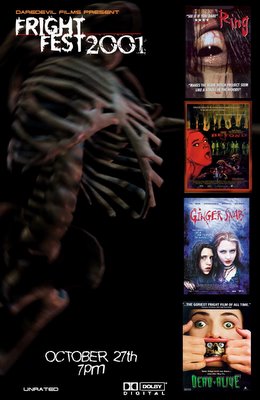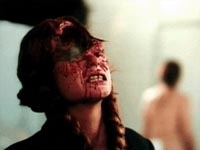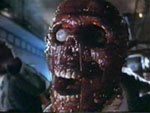 For Frightfest 2001 I picked a lineup of 4 movies, six hours worth of ass-numbing stuff: the original Japanese Ring (now known as Ringu in the wake of The Ring's success), Lucio Fulci’s The Beyond, Ginger Snaps and Dead Alive.
For Frightfest 2001 I picked a lineup of 4 movies, six hours worth of ass-numbing stuff: the original Japanese Ring (now known as Ringu in the wake of The Ring's success), Lucio Fulci’s The Beyond, Ginger Snaps and Dead Alive.Our party punch that year was some kind of toxic green sludge made from ice cream and orange juice. I can’t remember if it was the punch or something else to which Satanica added the gargantuan ice cube in the shape of a human brain. Ensign Harry Kim brought over a cake that looked like kitty litter in a kitty litter pan, complete with a poop scooper and little Tootsie Roll turds (which had the unfortunate effect of making sure everyone was afraid to eat it).
At that point in time, Ring was a movie talked about a lot on Internet message boards and websites, and had played theatrically in the UK and France (and obviously Asia), but was unknown by American audiences. Dreamworks had acquired the remake rights, so by Halloween 2002 everyone would know of The Ring – which made it an ideal pick to start out our marathon. Thanks to the magic of eBay, I was able to track down a PAL copy of the movie from Tartan Video.
I was unfamiliar with the bulk of Japanese horror films prior to Ring in 1998, and being as impressed with it as I was I tried to track down just about all of them I could find afterwards. Although I recognize that elements which made Ring so strong – the female specter with long black hair, the use of haunted technology, etc – had been a staple of Japanese horror films for years (“The Woman in the Snow” segment of 1964’s Kwaidan being one example), the simple, ticking-time bomb structure of Ring made it a perfect, uncomplicated shocker.
Journalist Reiko Asakawa (Nanako Matsushima) gets wind of a story of an urban legend, a video tape that kills you exactly one week after you watch it, after her niece dies unexpectedly. After finding a copy of the tape - of disjointed, surreal images made disturbing by their lack of context – she receives a phone call that informs her she has one week to live, and her countdown begins. She enlists the help of her ex-husband Ryuji (Hiroyuki Sanada), a math teacher, to discover the origins of the tape before her time runs out. The situation is complicated when her young son, Yoichi, steals a look at the tape and puts himself in danger.

Subtitles tick off the passing days as a suffocating sense of dread clouds the proceedings. The investigation leads to a remote island where the truth is revealed about Sadako, the evil spawn of a local psychic. Sadako, it is told by a local fisherman, had a greater mental power than even her mother, possessing the ability to kill people with her mind.
It is here that the film winds up to a satisfying but familiar conclusion: shades of The Changeling figure as the duo discover Sadako’s final resting place, a covered well, in the hopes that a proper burial will lay the malevolent spirit to rest. Moments before the time is up, Sadako’s remains are unearthed, seemingly sparing Reiko, Ryuji and Yoichi a grisly fate.
And then, after lulling the audience into a sense of safety, the terror cranks back up again as Ryuji is attacked in his apartment by a ghost that crawls out of the television, in the film’s most notorious scene. Reiko realizes she was spared Sadako’s wrath because she made a copy of the tape, and Ryuji watched it… and she understands what she must do to save Yoichi. The ring of terror continues…
Despite echoes of The Changeling, Videodrome and Scanners (plus a final shot that mirrors the end of The Terminator), Ring is in fine form for delivering the goods. It was a massive hit in Japan and Asia, spawning a number of remakes, sequels, TV movies and mini-series. It went over well with the Frighfest group, for whom we cooked up a gimmick that went largely unrecognized: Tartan’s DVD contained the “cursed tape” video clip, which we played following the movie. Big Rig Mohammed was in on the gag, using his cell phone to call the house immediately after it finished, but it had limited effect.
I should point out that at this point, we were just swapping out DVDs between movies; in later years, thanks to a program called DVD Shrink, I was able to build programming on DVD-R’s, including trailers, shorts and the feature presentation.
We followed up with The Beyond, a film I had caught wind of the preceding year due to both Quentin Tarantino’s publicized involvement as “presenter”, and its theatrical re-release as a midnight movie. It actually played the Music Box Theater in Chicago, the closest place we could have seen it.
The Grindhouse Releasing logo sets the mood perfectly, a kaleidoscope of color with scratchy 70’s audio, which calls up images of dilapidated, junkie-haunted, urine-stained, sprung-seating of 42nd Street’s infamous movie palaces gone to seed.
Torch-wielding townsfolk arrive at the Seven Doors Hotel in opening moments reminiscent of Universal’s gothic horrors. The subject of their bloodlust is an artist named Schweick, whom they whip with a chain (which rips off chunks of his skin), nail to a wall (the camera lingers on spikes being pounded into his wrists, blood pouring forth), and dissolve with boiling lye (an obvious dummy head fizzes and melts) before walling him up for all eternity.
Early on, Italian director Lucio Fulci (the Godfather of Gore) has announced his film’s intentions. What follows barely makes one lick of sense - as scenes rarely flow into the next, and characters appear and disappear at random – but its appeal lies in it’s headlong, devil-may-care style that lingers long on gore (most clearly artificial) where more “respectable” fare would cut away.
 Fulci’s secret weapon is cinematographer Sergio Salvatti scope photography, which gives the film a thick, Southern-gothic atmosphere, despite that the bulk of the shooting took place on Italian soundstages.
Fulci’s secret weapon is cinematographer Sergio Salvatti scope photography, which gives the film a thick, Southern-gothic atmosphere, despite that the bulk of the shooting took place on Italian soundstages.
Liza (Fulci regular Catroina MacColl) inherits the Seven Doors Hotel in the present day of 1981 and begins renovations in hopes of making a living off the joint. Of course, spooky events begin right away, which include a painter falling from a scaffold after seeing eyes staring at him through a window, and a plumber getting his eye gouged out in the basement.
Dr. John McCabe (David Warbeck) is summoned, and he listens skeptically to Liza’s interpretation of supposed supernatural events. A strange, blind woman named Emily appears to Liza and explains the haunted history of the hotel, and apparently for this blasphemy the crispy corpse of Schweick appears and somehow commands her dog ("Attack, Dickie, attack!") to rip her throat out in a blatant steal from Dario Argento’s Suspiria.
The hotel, as luck would have it, stands over one of the Seven Gates to Hell, which, when opened, rips the fabric of space and time and unleashes a zombie horde. One of the most startling and eerie shots in the entire film occurs after Liza and McCabe flee the previously empty hotel – lights come on and silhouettes of it’s former occupants are seen wandering past the windows.
The twosome retreat to the hospital, where they are confronted by the walking dead. Seeking an escape from the escalating apocalypse, they find themselves somehow in the basement of the hotel. Fleeing through a hole in the wall, they wind up in a blasted, barren landscape that mirrors Schweick’s painting of hell – and from which there is no escape.
The Beyond was originally released in the US in 1981 under the title The Seven Doors of Death, and was heavily edited, re-scored, and credited to director “Louis Fuller”. No review can do justice to the experience of actually watching this movie. At Frightfest we were howling as Liza tells her pal he “has carte blanche – but not a blank check”; as characters walked past a hospital door labeled “Do Not Entry”; as a gaggle of noisy tarantulas (well, at least one tarantula and a couple of models) eat a man’s face off, gorily eating his lips, puncturing his tongue and pulling out his eyeball, all in graphic close-up. And this is only the tip of the iceberg.
Having seen a couple of other Fulci flicks, including The House by the Cemetery (also starring MacColl), Zombie (aka Zombie Flesh Eaters and Zombi 2) and The City of the Living Dead, I can attest that this is Lucio’s masterpiece. (The Psychic, starring Jennifer O’Neill, may be more accomplished – but for sheer full-throttle, go for broke, gorehound lunacy this is tough to beat).
It is also helped immeasurably by the consumption of alcohol.
Next up – 2000’s Ginger Snaps. I actually programmed this movie for the marathon sight unseen, based on the overwhelming number of positive reviews that appeared on the Internet following its Canadian release. How this movie dodged an American theatrical release is beyond me, as it is one of the sharpest horror films in recent years, delivering the entertainment goods and some pointed satire in spades.
Thankfully, Canadian distributor TVA had a DVD released just a week or so prior to Halloween, so I was able to snap it up prior to its American, direct-to-video debut. (Adding further insult to injury, the U.S. Fox/Key Video DVD release is full screen and without any extras; the TVA edition is widescreen and overflowing with added material).
Sisters Ginger (Katherine Isabelle) and Brigitte (Emily Perkins) are misfits, evidenced by a class project in which they pose for mock up photographs of variations of their own deaths. The girls are inseparable in their misery, hating their home life with perennially upbeat Mom (Mimi Rogers), and swearing a blood-pact that they’ll be “out by sixteen or dead in this scene, but together forever”. Things take a change for the worst when, walking home one night, Ginger gets her first period - attracting the Beast of Bailey Downs: a werewolf that has been eviscerating local pets.
Bitten by the beast, Ginger begins to change – her awakening sexuality attracting attention from boys and resentment from girls, and mentally growing distant from Brigitte. Increasingly alarmed by her sister’s aggressive (and eventually homicidal) appetites, Brigitte turns to schoolyard drug dealer Sam (Kris Lemche), who ran the werewolf over with his van the night of the initial attack. Together, they attempt to develop a cure in the form of mainlined monkshood/wolfsbane, before the full moon brings out the animal in Ginger.
 Ginger Snaps takes the traditional werewolf story and updates it by using it as metaphor for a girl entering puberty, with surprising results. The strongest hook is the relationship between the two sisters, and the credible chemistry between Isabelle and Perkins. Mimi Rogers’ mother is a hoot and a half, celebrating the onset of her daughter’s menstrual cycle with a cake dripping with strawberry glaze.
Ginger Snaps takes the traditional werewolf story and updates it by using it as metaphor for a girl entering puberty, with surprising results. The strongest hook is the relationship between the two sisters, and the credible chemistry between Isabelle and Perkins. Mimi Rogers’ mother is a hoot and a half, celebrating the onset of her daughter’s menstrual cycle with a cake dripping with strawberry glaze.
Two sequels followed, Ginger Snaps: Unleashed and Ginger Snaps: The Beginning, both released in 2004. Unfortunately, in order to carry the story forward, the central metaphor was lost, and both films bombed at the Canadian box office. Katherine Isabelle became a hot commodity in Hollywood for a short time after Ginger Snaps, appearing in the Snoop Dogg horror vehicle Bones, Christopher Nolan’s remake of Insomnia opposite Al Pacino, and in the terror titan throw down Freddy vs Jason. Kris Lemche turned up in a movie I caught (and liked quite a bit) called My Little Eye.
This was the only year we showed four movies in our marathon – having shortened the playlist to three in subsequent years. For the fourth and final film of the night, we needed something energetic and funny – and for Frightfest 2001 it was Peter Jackson’s Dead Alive.
Yep, long before he was winning awards with the Lord of the Rings movies, or resurrecting gargantuan apes in King Kong, Peter Jackson was known for making a couple of seriously demented flicks such as Meet the Feebles (an R rated comedy starring Muppet-like characters), and Bad Taste! (about a gory alien invasion), and this instant classic of the horror genre.
Billed on ads as “the goriest fright film of all time”, Dead Alive tells the story of Lionel (Timothy Balme), who lives a very Norman Bates-ish existence in a foreboding Victorian mansion with his domineering mother, Vera (Elizabeth Moody). Vera, a busy body in local affairs, insists that she be the only woman in Lionel’s life. Naturally, it doesn’t sit well when he meets Paquita (Diana Penalver), a local grocer’s daughter. Following the two lovebirds on a date to the zoo, Vera is bitten by the dreaded Sumerian rat monkey, a mythical animal captured on a bloody expedition in the movie’s opening moments.
Due to the rat monkey’s bite, Vera dies – and is resurrected as a zombie, infecting all others she comes in contact with by a fatal bite. In order to keep Mum with him, Lionel keeps her and the other zombies in the basement of the house, which becomes complicated by the arrival of his Uncle Les (Ian Watkin). Lecherous Les is interested in shutting Lionel out of the house and his inheritance, and after finding the zombies in the basement, discovers a method of blackmail.
Things quickly spiral out of control as Lionel and Paquita try to deal with the escalating zombie crisis, culminating in an event at Les’ house party where all of the zombies converge, transforming the guests into more of the living dead. Lionel’s solution to this situation is one of the film’s most memorable moments, where he plows through the undead brandishing a twirling lawnmower. All of this leads to a climax in which Lionel faces off with a gargantuan, bloated and hideous version of his mother on the roof of the house, where he finally severs the apron strings once and for all.
All of this leads to a climax in which Lionel faces off with a gargantuan, bloated and hideous version of his mother on the roof of the house, where he finally severs the apron strings once and for all.
Dead Alive is absolute hilarious, go for broke insanity for anyone willing to take the over-the-top bloodshed with a grain of salt. There’s the minister who claims “I kick ass for the Lord” before opening up a can of kung-fu whoop-ass on churchyard hooligans; a masterful scene of comic timing in which Lionel tries to take a hideously cute zombie tyke (the product of a heated mating between the undead vicar and a headless zombie nurse) to the playground; and all manner of good bits during the climactic house party bloodbath.
Originally released in New Zealand in 1992 at 104 minutes and titled Braindead, the film was re-named in the States to avoid confusion with Adam Simon’s Brain Dead from 1990, starring Bill Pullman and Bill Paxton. It was also cut down to 97 minutes, which according to Peter Jackson, is his preferred cut. Another, 85 minute version was prepared in order to get an R rating.
We ran a Frightfest Trivia Game towards the end of the night, which I created on Adobe Premiere and burned to disc; it featured 15 questions or so from the length and breadth of the horror movie genre. The prizes awarded to the three top scores included a voodoo statuette, a bowl of Halloween candy, and a set of skull shotglasses.
As consolation prizes, we handed out CDs featuring music from various horror movie scores. The track listing for the 2001 CD is as follows:
Halloween II
Creepshow
A Nightmare on Elm Street
The Exorcist
Hellraiser
Friday the 13th
Suspiria
The Fog
Psycho
Dawn of the Dead
The Beyond
The Thing
The Blair Witch Project
Comments